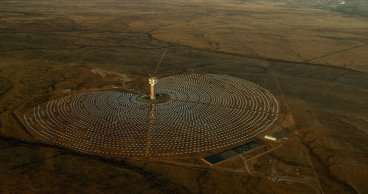
Tim Mack
Submitted by Tim Mack on
Once a year I try to check in on renewable power issues, and I believe that solar has the most potential but faces the most challenges.
The Solar Energy Industries Association (SEIA) reports that 43% of new energy capacity added in the United States in 2020 came from solar—the greatest annual increase to date. This additional capacity added up to 19.2 gigawatts (GW), and new installations coming over the next decade will be close to 325 GW, SEIA estimates.
A related element in this expansion is the repurposing of brownfields:
- Near Houston, a 240-acre site scheduled to be online by the end of 2022 will be the largest repurposed solar site in the U.S. As a public–private endeavor between the city of Houston and Sunnyside Energy, it combines climate action initiatives and community building for underserved urban communities.
- In Healdsburg, California, a new floating solar facility sited on water treatment ponds at the city wastewater plant is the largest floating plant constructed in the U.S. to date.
- In West Texas, the Danish company Ørsted, using Chinese PV panels, has just completed a 1.3 million panel installation on a 3,600-acre site in the Permian shale basin.
These are heady growth figures, but logistic challenges continue to accompany ground-level solar farms and urban rooftop installations. One critical challenge that affects other renewable energy arenas, including wind power (and oil and gas as well—especially offshore) is the continued health, safety, and operational viability of workers in what has been a work theater marked by accidents, injuries, and work-related illnesses.
With the COVID pandemic expanding those levels of risk, steady growth in the overall energy arena has not been guaranteed over the past 20+ months. Offsetting these challenges, however, is the expansion of remote medicine and emergency response in the renewable energy field, where installations can be sited in relatively rural and remote areas, such as offshore sites, without additional risk to site staff.
In spite of these increases in decarbonization, fossils fuels continue to supply more than 80% of global energy demands, as the scale and cost of decarbonizing the global energy system remain quite significant. The share of fossil fuels in the world’s total energy mix is still as high as a decade ago, despite the falling cost of renewables and pressure on governments to act on climate change, according to a report by green energy policy network REN21. Use of fossil fuels continues to be driven by rising global energy demand, continued investment in new fossil fuel plants, and lower use of biomass energy—such as wood or agricultural waste—in heating and cooking. Although China recently announced it will not build new coal-fired energy plants anywhere in the world, it is just one player in the global energy industry.
Energy-intensive sectors—including power, transport, heavy industry, and buildings—are increasing their decarbonization efforts, driven by increasing government and consumer demand for rapid reductions in CO2 emissions. Bloomberg NEF notes that achieving net-zero emissions will require between $92 trillion and $173 trillion in infrastructure investments in the energy sector alone, between now and 2050.
And even small gains in flexibility, efficiency, or capacity in clean energy and low-carbon industry could lead to trillions of dollars in value and savings. As electricity supplies more sectors and applications, ramping up renewable energy deployment to decarbonize the globally expanding power sector can mean more power is supplied by intermittent sources (such as solar and wind), creating new demand for forecasting, coordination, and flexible consumption capability to ensure that power grids can be operated safely and reliably. Accordingly, transition to low-carbon energy systems will drive a rapid growth of distributed power generation, distributed storage, and advanced demand-response capabilities, which need to be orchestrated and integrated through more networked, transactional power grids.
One strategy for meeting these challenges is the continuing growth in the use of artificial intelligence (AI) in managing and developing alternative energy applications—and the potential for increasing decarbonization worldwide. Navigating these trends presents huge strategic and operational challenges to the energy system and to energy-intensive industries. And this is where AI can create an intelligent coordination layer across the generation, transmission, and use of energy. AI can help energy-system stakeholders identify patterns and insights in data, learn from experience to improve system performance over time, and predict and model possible outcomes of complex, multivariate situations.
AI applications are already driving measurable improvements in renewable energy forecasting, grid operations and optimization, coordination of distributed energy assets, and demand-side management, plus materials innovation and discovery. However, while AI’s application in the energy sector has been promising so far, AI innovation and adoption remain slower than initially anticipated. While that is frustrating, increased AI enhancement presents the opportunity to accelerate the transition toward the zero-emission, highly efficient, and interconnected energy systems.
This would include
- adopting best practices for sustainable computing designed to limit the carbon footprint of AI,
- focusing AI development on usability and interpretability,
- establishing data standards, data-sharing mechanisms, and platforms to increase the availability and quality of data,
- empowering consumers and the energy workforce with a human-centered AI approach designed to match technology and skill development,
- implementing compatible software standards and interoperable interfaces to manage the risks presented by AI, and
- ensuring that ethics and responsible use are at the core of development and deployment.
Given the urgent need to scale up a global energy transition, we can’t afford to leave any tools in the toolbox. Used well, AI will accelerate the energy transition while expanding access to energy services, encouraging innovation, and ensuring a safe, resilient, and affordable clean energy system.
This is not to say, however, that AI technology can replace an essential need for aggressive political, corporate, and NGO commitment to reducing emissions worldwide at an increasing rate if the climate crisis is going to be met and successfully managed in the future.
References
Nina Chestney, “Global fossil fuel use similar to decade ago in energy mix,” Reuters (June 14, 2021).
Duncan Higham, “Healthcare and safety: Important considerations on offshore wind farms,” Windpower Energy & Development (February 1, 2021).
“Houston City Council Approves Largest Brownfield Solar Project in the Nation” (press release), Mayor’s Office (January 14, 2021).
“Permian Energy Centre” NS Energy.
Espen Mehlum, Dominique Hischier, and Mark Caine, “This is How AI will Accelerate the Energy Transition,” The Agenda Weekly, World Economic Forum (September 3, 2021).
World Economic Forum, with BloombergNEF and Energie-Agentur (DENA), “Harnessing Artificial Intelligence to Accelerate the Energy Transition” (September 2021).
“Innovation Landscape For A Renewable-Power Future: Solutions to integrate variable renewables,” International Renewable Energy Agency, IRENA (2019).
Brian Valentine, “AMO MYPP: Moving Applications of AI and ML from Materials Design and Discovery through Process Design and Development,” U.S. Department of Energy, Office of Energy Efficiency and Renewable Energy, Advanced Manufacturing Office (July 12, 2018).
About the Author
Timothy C. Mack is managing principal of AAI Foresight Inc. He may be reached at tcm333@gmail.com.
Image credit: Christo Ras from Pixabay

